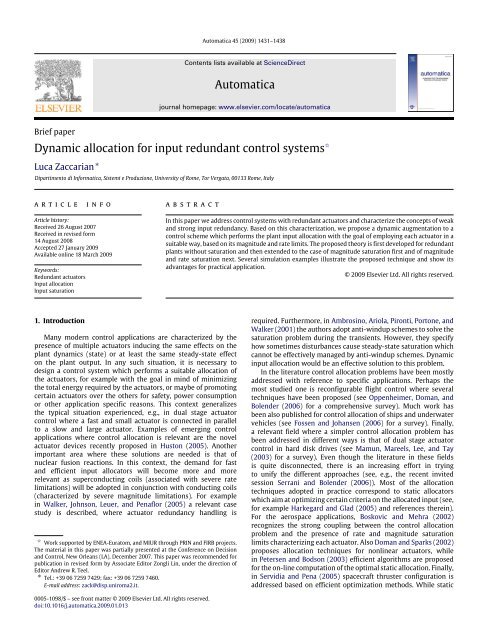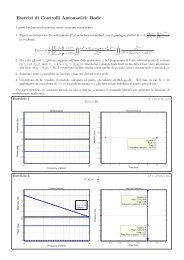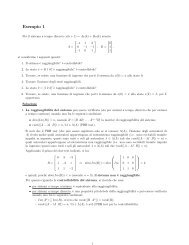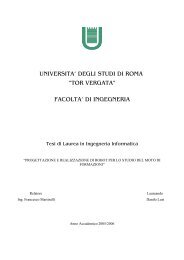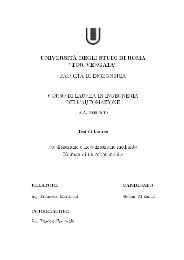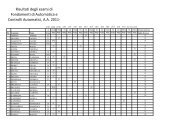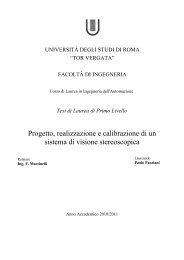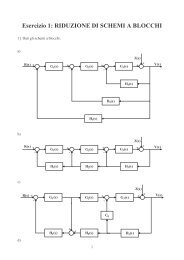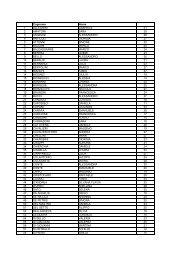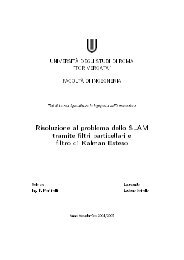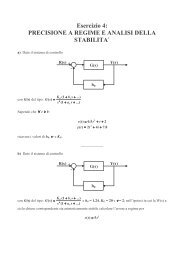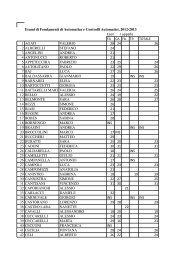Automatica Dynamic allocation for input redundant control systems$
Automatica Dynamic allocation for input redundant control systems$
Automatica Dynamic allocation for input redundant control systems$
You also want an ePaper? Increase the reach of your titles
YUMPU automatically turns print PDFs into web optimized ePapers that Google loves.
<strong>Automatica</strong> 45 (2009) 1431–1438Contents lists available at ScienceDirect<strong>Automatica</strong>journal homepage: www.elsevier.com/locate/automaticaBrief paper<strong>Dynamic</strong> <strong>allocation</strong> <strong>for</strong> <strong>input</strong> <strong>redundant</strong> <strong>control</strong> systems ✩Luca Zaccarian ∗Dipartimento di In<strong>for</strong>matica, Sistemi e Produzione, University of Rome, Tor Vergata, 00133 Rome, Italya r t i c l ei n f oa b s t r a c tArticle history:Received 26 August 2007Received in revised <strong>for</strong>m14 August 2008Accepted 27 January 2009Available online 18 March 2009Keywords:Redundant actuatorsInput <strong>allocation</strong>Input saturationIn this paper we address <strong>control</strong> systems with <strong>redundant</strong> actuators and characterize the concepts of weakand strong <strong>input</strong> redundancy. Based on this characterization, we propose a dynamic augmentation to a<strong>control</strong> scheme which per<strong>for</strong>ms the plant <strong>input</strong> <strong>allocation</strong> with the goal of employing each actuator in asuitable way, based on its magnitude and rate limits. The proposed theory is first developed <strong>for</strong> <strong>redundant</strong>plants without saturation and then extended to the case of magnitude saturation first and of magnitudeand rate saturation next. Several simulation examples illustrate the proposed technique and show itsadvantages <strong>for</strong> practical application.© 2009 Elsevier Ltd. All rights reserved.1. IntroductionMany modern <strong>control</strong> applications are characterized by thepresence of multiple actuators inducing the same effects on theplant dynamics (state) or at least the same steady-state effecton the plant output. In any such situation, it is necessary todesign a <strong>control</strong> system which per<strong>for</strong>ms a suitable <strong>allocation</strong> ofthe actuators, <strong>for</strong> example with the goal in mind of minimizingthe total energy required by the actuators, or maybe of promotingcertain actuators over the others <strong>for</strong> safety, power consumptionor other application specific reasons. This context generalizesthe typical situation experienced, e.g., in dual stage actuator<strong>control</strong> where a fast and small actuator is connected in parallelto a slow and large actuator. Examples of emerging <strong>control</strong>applications where <strong>control</strong> <strong>allocation</strong> is relevant are the novelactuator devices recently proposed in Huston (2005). Anotherimportant area where these solutions are needed is that ofnuclear fusion reactions. In this context, the demand <strong>for</strong> fastand efficient <strong>input</strong> allocators will become more and morerelevant as superconducting coils (associated with severe ratelimitations) will be adopted in conjunction with conducting coils(characterized by severe magnitude limitations). For examplein Walker, Johnson, Leuer, and Penaflor (2005) a relevant casestudy is described, where actuator redundancy handling is✩ Work supported by ENEA-Euratom, and MIUR through PRIN and FIRB projects.The material in this paper was partially presented at the Conference on Decisionand Control, New Orleans (LA), December 2007. This paper was recommended <strong>for</strong>publication in revised <strong>for</strong>m by Associate Editor Zongli Lin, under the direction ofEditor Andrew R. Teel.∗ Tel.: +39 06 7259 7429; fax: +39 06 7259 7460.E-mail address: zack@disp.uniroma2.it.required. Furthermore, in Ambrosino, Ariola, Pironti, Portone, andWalker (2001) the authors adopt anti-windup schemes to solve thesaturation problem during the transients. However, they specifyhow sometimes disturbances cause steady-state saturation whichcannot be effectively managed by anti-windup schemes. <strong>Dynamic</strong><strong>input</strong> <strong>allocation</strong> would be an effective solution to this problem.In the literature <strong>control</strong> <strong>allocation</strong> problems have been mostlyaddressed with reference to specific applications. Perhaps themost studied one is reconfigurable flight <strong>control</strong> where severaltechniques have been proposed (see Oppenheimer, Doman, andBolender (2006) <strong>for</strong> a comprehensive survey). Much work hasbeen also published <strong>for</strong> <strong>control</strong> <strong>allocation</strong> of ships and underwatervehicles (see Fossen and Johansen (2006) <strong>for</strong> a survey). Finally,a relevant field where a simpler <strong>control</strong> <strong>allocation</strong> problem hasbeen addressed in different ways is that of dual stage actuator<strong>control</strong> in hard disk drives (see Mamun, Mareels, Lee, and Tay(2003) <strong>for</strong> a survey). Even though the literature in these fieldsis quite disconnected, there is an increasing ef<strong>for</strong>t in tryingto unify the different approaches (see, e.g., the recent invitedsession Serrani and Bolender (2006)). Most of the <strong>allocation</strong>techniques adopted in practice correspond to static allocatorswhich aim at optimizing certain criteria on the allocated <strong>input</strong> (see,<strong>for</strong> example Harkegard and Glad (2005) and references therein).For the aerospace applications, Boskovic and Mehra (2002)recognizes the strong coupling between the <strong>control</strong> <strong>allocation</strong>problem and the presence of rate and magnitude saturationlimits characterizing each actuator. Also Doman and Sparks (2002)proposes <strong>allocation</strong> techniques <strong>for</strong> nonlinear actuators, whilein Petersen and Bodson (2003) efficient algorithms are proposed<strong>for</strong> the on-line computation of the optimal static <strong>allocation</strong>. Finally,in Servidia and Pena (2005) spacecraft thruster configuration isaddressed based on efficient optimization methods. While static0005-1098/$ – see front matter © 2009 Elsevier Ltd. All rights reserved.doi:10.1016/j.automatica.2009.01.013
1432 L. Zaccarian / <strong>Automatica</strong> 45 (2009) 1431–1438techniques are more popular <strong>for</strong> <strong>input</strong> <strong>allocation</strong>, some dynamicapproaches have also been proposed, which are more similar to thekey ideas in this paper. In Johansen (2004) a dynamic approach isproposed where the dynamical <strong>allocation</strong> asymptotically recoversthe pseudo-inverse <strong>allocation</strong> <strong>for</strong> <strong>redundant</strong> linear systems. Theapproach is therein <strong>for</strong>mulated <strong>for</strong> nonlinear systems and alsoapplied to over-actuated ship maneuvering. The difference withrespect to this paper is that we explicitly focus here on the presenceof (rate and magnitude) actuator saturations and optimize the<strong>allocation</strong> in view of those saturations, whereas the approachin Johansen (2004) is much more general and leads to lessintuitive and more computationally expensive solutions. A socalled‘‘dynamic <strong>allocation</strong> scheme’’ was also proposed in Luo,Serrani, Yurkovich, Doman, and Oppenheimer (2005) based ona sampled-data scheme using RHC ideas. However in this lastpaper the term ‘‘dynamic’’ denotes the fact that actuator dynamicsare accounted <strong>for</strong> in the <strong>allocation</strong> scheme, which is a RecedingHorizon law (the solution to a static optimization problem).Conversely, in this paper we use dynamics inside the allocatorequations.The core idea of this paper is that when <strong>input</strong> redundancy isat hand, it is possible to inject an arbitrary signal in certain <strong>input</strong>directions without affecting the state response of the plant (in thestrongly <strong>redundant</strong> case) or the steady-state output response of theplant (in the weakly <strong>redundant</strong> case). These signals are selectedas the outputs of a suitable number of integrators whose stateis adjusted on-line based on certain gains intuitively chosen topromote/penalize the different actuators based on their rate ormagnitude saturation levels. The proposed ideas are presented<strong>for</strong> the linear case but they can be generalized to the nonlinearcase: the generalization to nonlinear <strong>control</strong>lers is straight<strong>for</strong>ward,while the generalization to nonlinear plants is more involvedbecause closed-<strong>for</strong>m solutions to the stabilization of rate andmagnitude saturated plants are not readily available. In Section 2we give some basic definitions. In Section 3 we describe the<strong>input</strong> <strong>allocation</strong> scheme <strong>for</strong> linear <strong>control</strong> systems. In Section 4we generalize it to the case of <strong>input</strong> magnitude saturation and inSection 5 we further extend it to the case of magnitude and ratesaturation. Several examples are given throughout the paper toillustrate the proposed techniques.2. Input <strong>redundant</strong> systemsConsider a linear <strong>control</strong> system involving a linear plantẋ = Ax + Bu + B d dy = Cx + Du + D d d,(where x ∈ R n is the plant state, u ∈ R n uis the plant <strong>input</strong>, y ∈ R n yis the plant output and d ∈ R n dis a disturbance <strong>input</strong>) satisfying an<strong>input</strong> redundancy assumption, as <strong>for</strong>malized in the next definition.Definition 1. The plant (1) is <strong>input</strong> <strong>redundant</strong> if one of thefollowing two conditions is satisfied([ ])• Bit is strongly <strong>input</strong> <strong>redundant</strong> from u if it satisfies Ker ≠ ∅;Din this case it is useful to introduce the following full columnrankmatrix:([BB ⊥ such that Im(B ⊥ ) = Ker ; (2)D])• it is weakly <strong>input</strong> <strong>redundant</strong> from u to y if P ⋆ := lim s→0 (C(sI −A) −1 B + D) is a finite matrix which satisfies Ker(P ⋆ ) ≠ ∅; inthis case it is useful to introduce the following full column-rankmatrix:B ⊥ such that Im(B ⊥ ) = Ker(P ⋆ ). (3)Remark 1. When there is at least one pole at the origin, the DCgain of the corresponding <strong>input</strong>–output pair is infinity so that at the(1)steady state the corresponding <strong>input</strong> must be zero. This fact makesit impossible to re-allocate the <strong>input</strong> which must evidently remainat zero in any steady-state situation. There<strong>for</strong>e, the requirementthat P ⋆ is finite in the weak <strong>input</strong> redundancy part of Definition 1 isnot restrictive. One may also focus on a restricted number of <strong>input</strong>sto obtain P ⋆ < ∞. ○In this paper we address the problem of exploiting the <strong>input</strong>redundancy of the plant (1) to induce desirable <strong>input</strong> <strong>allocation</strong>sduring the evolution of a generic <strong>control</strong> system which canbe thought of as the feedback interconnection of (1) with thefollowing linear <strong>control</strong>ler 1ẋ c = A c x c + B c u c + B r ry c = C c x c + D c u c + D r r,u c = y.(4a)(4b)In this paper, an <strong>input</strong> allocator block is inserted between the<strong>redundant</strong> <strong>input</strong> u of the plant and the <strong>control</strong>ler output y c . Inparticular, <strong>for</strong> the case of strong <strong>input</strong> redundancy, the <strong>input</strong>allocator will be designed in such a way that it is completelyinvisible to the <strong>control</strong>ler. Static <strong>allocation</strong> would do a similar jobin this case. Conversely, with weak <strong>input</strong> redundancy, the allocatorwill cause transients at the plant output and will inevitably interactwith the <strong>control</strong> system, so that its speed must be sufficiently slow.For this last case, static allocators cannot be used and the theorydeveloped here provides effective solutions to this problem.3. Linear dynamic <strong>input</strong> <strong>allocation</strong>3.1. Strong <strong>input</strong> redundancyAssume that the plant (1) is strongly [ <strong>input</strong> <strong>redundant</strong> andBconsider the basis of the null space of D]introduced in (2). Note[ ]that the matrix B ⊥ satisfies B T ⊥ B ⊥ > B0 and BD ⊥ = 0.Consider the addition of the following dynamic <strong>input</strong> allocatorat the <strong>input</strong> of the plant (1)ẇ = −KB T ⊥ ¯W uu = y c + B ⊥ w,where K and ¯W are suitable matrices to be specified next. Then thefollowing result holds.Theorem 1. Assume that the plant (1) is strongly <strong>input</strong> <strong>redundant</strong>and consider the <strong>control</strong> system with <strong>input</strong> <strong>allocation</strong> namely (1), (4),(5) and (2) and the <strong>control</strong> system without <strong>input</strong> <strong>allocation</strong> namely(1) and (4), u = y c .If K and ¯W in (5) are symmetric and satisfy K > 0 and BT⊥ ¯W B⊥ >0, then:(1) the <strong>control</strong> system with <strong>input</strong> <strong>allocation</strong> is internally stable if andonly if the <strong>control</strong> system without <strong>input</strong> <strong>allocation</strong> is internallystable;(2) given any initial condition (x(0), x c (0), w(0)) and any selectionof the external signals r(·), d(·), the plant output responses of thetwo systems coincide <strong>for</strong> all times.Proof. It is straight<strong>for</strong>ward to verify that since BB ⊥ = 0, the<strong>control</strong> system with <strong>input</strong> <strong>allocation</strong> can be written as the cascadeinterconnection of a first subsystem consisting in (4) and (1)withu = y c , which drives via the signal y c a second subsystemconsisting in the dynamic allocator (5). There<strong>for</strong>e the plant outputy is independent of the dynamic allocator output w. To showinternal stability it is sufficient to show internal stability of thedynamic allocator (because of the cascade interconnection). To thisend, consider the Lyapunov function V(w) = 1 2 wT K −1 w and note1 The <strong>control</strong>ler (4) can be generalized to a generic locally Lipschitz <strong>control</strong>ler.The attention here is restricted to the linear case to increase the clarity of the paper.(5)
that ˙V = −w T B T ⊥ ¯W B ⊥ w − w T B T ⊥ ¯W y c , which implies internalstability because B T ⊥ ¯W B ⊥ > 0 by assumption. •Remark 2 (Speed of the <strong>Dynamic</strong> Allocator). Theorem 1 establishesthat any (arbitrarily fast) dynamics in the dynamic allocator (5)can be implemented because the dynamics of w are completelyinvisible to the plant-<strong>control</strong>ler dynamics. Due to this fact, givendesirable matrices W d and K d , the speed of the allocator canbe adjusted from extremely slow to extremely fast by selectingdifferent values of a positive scalar ρ in the selection K = ρK d ,¯W = W d . Indeed, by Theorem 1, any positive value of ρ will beallowed and given any <strong>control</strong>ler output y ∗ cthe magnitude of ρwill regulate the speed of convergence to the steady-state <strong>input</strong><strong>allocation</strong>, which is independent of K d and is given byL. Zaccarian / <strong>Automatica</strong> 45 (2009) 1431–1438 1433u ⋆ = ( I − B ⊥ (B T ⊥ ¯W B ⊥ ) −1 B T ⊥ ¯W ) y ⋆ c . (6)This equation is easily derived from (5) by imposing the steadystatecondition ẇ = 0 and corresponds to the solution to thefollowing optimization problem:min J(u) :=wuT ¯W u, subject tou = y ⋆ + c B ⊥w,as a matter of fact, imposing the stationary condition ∂J(u(w))∂w= 0, Eq. (6) is easily determined. ○Remark 3 (Shifting the Allocator Center). It is worth mentioningthat an arbitrary (not necessarily constant) signal u 0 ∈ R n ucan besubtracted from u at the right hand side of the <strong>input</strong> allocator (5), aswell as its generalizations reported next. In this way, the distance ofu from u 0 (rather than from the origin) is penalized by the allocator.This trick allows one, <strong>for</strong> example, to account <strong>for</strong> non-symmetricsaturations, as well as certain desirable operating conditions <strong>for</strong>some of the plant <strong>input</strong>s. For example, if the first equation in (5) isreplaced by ẇ = −KB T ⊥ ¯W(u − ū 0 ), where ū 0 is constant, then thesteady-state <strong>input</strong> <strong>allocation</strong> (6) shifts tou ⋆ = y ⋆ c − B ⊥(B T ⊥ ¯W B ⊥ ) −1 B T ⊥ ¯W(y ⋆ c − ū 0),which is easily shown to be the solution to the followingoptimization problem, generalizing (7):min J ūw 0(u) := (u − ū 0 ) T ¯W(u − ū0 ), subject tou = y ⋆ + c B ⊥w. ○Remark 4 (Selecting the Parameters K and ¯W ). Theorem 1 impliesthat any positive definite pair of matrices K and ¯W in the dynamicallocator (5) will guarantee internal stability of the modified closedloop. This degree of freedom can be exploited in different ways.As an example, using a diagonal ¯W , it is possible to promote orpenalize the size of the different components of the plant <strong>input</strong>by suitably selecting, respectively, smaller or larger entries inthe diagonal of the matrix ¯W . Indeed, the larger an entry in ¯W ,the larger will be the correction automatically en<strong>for</strong>ced by theallocator when the corresponding <strong>input</strong> is nonzero. As <strong>for</strong> K , it canbe used to represent the <strong>control</strong> allocator with any basis B 0 of thenull space of B, as a matter of fact, given an orthonormal basis B ⊥and any basis B 0 , there always exists a coordinate change T suchthat B 0 T = B ⊥ and selecting ˜K = TKT T and defining ˜w = Tw, onegets the equivalent representation <strong>for</strong> (5):˙˜w = − ˜K BT0 ¯W uu = y c + B 0 ˜w,which corresponds to selecting B 0 as any basis of the null space ofB in (5). The general representation (8) is especially useful whenwanting to penalize the use of certain <strong>redundant</strong> directions whichcan be isolated in the generic basis B 0 . In that case, selecting the(7)(8)Fig. 1. Example 1: Responses to a unit step reference.matrix ˜K as a diagonal positive definite matrix, some <strong>redundant</strong><strong>input</strong> directions (corresponding to suitable columns of B 0 ) can bepenalized by making the corresponding entries in ˜K small. ○Remark 5 (Robustness with Respect to Errors on B ⊥ ). Since theproof of Theorem 1 (as well as the following theorems) relieson Lyapunov-based arguments and all the right hand sidesare Lipschitz, the scheme is robust with respect to arbitrarilysmall errors in B ⊥ . Moreover, a <strong>for</strong>mal robustness analysis withnontrivial estimates of the tolerable variations of B ⊥ can be carriedout based on a small gain argument. ○Example 1. Consider the following randomly generated exponentiallystable plant[ ] [ ]−0.157 −0.094 0.87 0.253 0.743A B= −0.416 −0.45 0.39 0.354 0.65 .C D0 1 0 0 0The plant is strongly <strong>input</strong> <strong>redundant</strong> with the orthonormalselection B ⊥ = [−0.27512 − 0.76512 0.58215] T . We design a<strong>control</strong>ler guaranteeing asymptotic tracking of constant referencesvia: (1) negative error feedback interconnection; (2) inserting anintegrator; (3) designing a stabilizing LQG <strong>control</strong>ler which onlyuses the first two <strong>input</strong> channels. The LQG <strong>control</strong>ler is designedusing identity matrices both <strong>for</strong> the <strong>input</strong> and state weights in theLQ index and <strong>for</strong> the covariance matrix of the state and outputequation noises. The arising matrices in (4) correspond to⎡⎤[ ]Ac B r=C c D r⎢⎣−1.57 0.5767 0.822 −0.65 0−0.9 −0.501 −0.94 0.802 00 1 −1.61 1.614 00 0 0 0 11.81 −1.2 −0.46 0 0−0.62 1.47 0.89 0 00 0 0 0 0,⎥⎦and to B c = −B r , D c = −D r .Note that this <strong>control</strong>ler is purposely selected as a dull<strong>control</strong>ler which never uses the third <strong>input</strong> channel, so the <strong>input</strong><strong>allocation</strong> <strong>for</strong> a given desired plant response can be improved interms of the size of each allocated <strong>input</strong>. We implement the <strong>input</strong>allocator (5) selecting K = 10I and ¯W = I. The correspondingresponse to a unit step reference is reported in Fig. 1 where thetop plot represents the output response y (this is independent ofthe <strong>control</strong> <strong>allocation</strong>), the middle plot represents the <strong>control</strong>leroutput y c (here, the third <strong>input</strong> channel is zero) and the bottom plot
1434 L. Zaccarian / <strong>Automatica</strong> 45 (2009) 1431–1438y c = C cl[xx c]+ D cl,d d + D cl,r r + D cl,w wFig. 2. Example 1: Different <strong>allocation</strong>s based on the choice of ¯W .represents the plant <strong>input</strong> u (note that the <strong>control</strong> allocator allowsreducing the steady-state size of the largest <strong>input</strong> to roughly onehalf as compared to the middle plot).Following the comments in Remark 4 about the selection of W ,we simulate three variants of the <strong>control</strong> allocator, selecting first¯W = diag([100 1 1]), then ¯W = diag([1 100 1]) and finally¯W = diag([1 1 100]). The resulting <strong>input</strong> <strong>allocation</strong>s are shown inthe top, middle and bottom plots of Fig. 2, respectively (the plantoutput responses are not reported because they all coincide withthe top plot of Fig. 1). Fig. 2 clearly illustrates the abilities of the<strong>control</strong> allocator to promote or penalize each <strong>control</strong> <strong>input</strong>. Forthis same example, an illustration of how the choice of K impactsthe convergence speed of the allocator can be easily carried out bysimulation (see Zaccarian (2008)).3.2. Weak <strong>input</strong> redundancyWith weak <strong>input</strong> redundancy the dynamic <strong>allocation</strong> transientsare visible at the plant output y, there<strong>for</strong>e there is a stronglimit in the dynamic <strong>allocation</strong> speed commented in Remark 2.The main result <strong>for</strong> weakly <strong>input</strong> <strong>redundant</strong> plants establishesthat there is a small enough speed such that the <strong>input</strong>–output<strong>allocation</strong> is effective (namely, closed-loop stability is retained).The corresponding dynamic allocator is given by (5) where B ⊥ nowassumes the meaning in (3). In the following we will denote as‘‘converging signal’’ any function t ↦→ s(t) such that lim t→∞ s(t)is well defined and finite.Theorem 2. Assume that the plant (1) is weakly <strong>input</strong> <strong>redundant</strong> andthat the <strong>control</strong> system without <strong>input</strong> <strong>allocation</strong> (namely (1) and (4),u = y c ) is internally stable. Consider the <strong>input</strong> allocator (5) with B ⊥ asin (3) and with K = ρ ¯K . If ¯K and ¯W are symmetric and satisfy ¯K > 0and B T ⊥ ¯W B ⊥ > 0, then there exists a small enough ρ such that:(1) the <strong>control</strong> system with <strong>input</strong> <strong>allocation</strong> (namely (1), (4), (5) and(3), K = ρ ¯K ) is internally stable and(2) Given any converging selection of the external signals r(·), d(·),the plant output responses of the two systems converge to thesame values.Proof. The closed-loop system with dynamic <strong>input</strong> <strong>allocation</strong> (1),(4), (5) and (3), K = ρ ¯K can be written in the following <strong>for</strong>m[ ] [ ]ẋ x= Aẋ cl + Bc x cl,d d + B cl,r r + B cl,w wcẇρ = − ¯K BT⊥ ¯W(B⊥ w + y c ),where the matrices with subscripts ‘‘cl’’ can be uniquely determinedfrom the plant and <strong>control</strong>ler matrices in (1) and (4). Then,by the internal stability assumption <strong>for</strong> the closed loop without <strong>input</strong><strong>allocation</strong>, standard results on systems with two time scales(see, e.g., Khalil (1996)) can be applied to conclude internal stabilityof the closed loop with <strong>input</strong> <strong>allocation</strong>. As <strong>for</strong> item (2), internalstability and linearity imply that any converging selection of external<strong>input</strong>s will lead to converging state responses. Since the plant(1) is linear, denoting by ⋆ the steady-state values of the signals, thesteady-state plant output will correspond to the sum of the contributionsarising from each one of the plant <strong>input</strong>s, namely y ⋆ =y ⋆ y c+y ⋆ d +y⋆ w = y⋆ y c+y ⋆ d because y⋆ w = P⋆ B ⊥ (B T ⊥ ¯W B ⊥ ) −1 B T ⊥ ¯W y ⋆ = c 0by the definition of B ⊥ in (3). Then by uniqueness of solutions, thesteady-state response y ⋆ will necessarily coincide with the steadystateresponse of the closed loop without <strong>input</strong> <strong>allocation</strong>. •Remark 6. The results in Theorem 2 imply that <strong>for</strong> a given <strong>control</strong>system where different <strong>control</strong> <strong>allocation</strong>s can lead to the samesteady-state output, it is possible to implement a slow enough<strong>control</strong> allocator such that the corresponding dynamics is on adifferent time scale from that of the plant-<strong>control</strong>ler closed loop.This approach is especially useful when wanting the plant <strong>input</strong>sto slowly drift toward a desired <strong>control</strong> <strong>allocation</strong> solution (see,e.g., the problems in Walker et al. (2005)). In this case, the value ofρ can be selected small enough so that the <strong>control</strong> allocator takescare of the slow drift which (by redundancy) is invisible to the plantoutput and to the feedback <strong>control</strong>ler. ○Remark 7. In the presence of both strong and weak <strong>input</strong>redundancy, it is possible to select the matrix B ⊥ so that the firstcolumns are in the strong redundancy directions. Then via suitablediagonal selections of the matrix K it is possible to combine theapproaches of Theorems 1 and 2 by simultaneously using differentspeeds of <strong>allocation</strong>. ○Example 2. Consider the <strong>control</strong> system introduced in Example 1.The plant is evidently weakly <strong>input</strong> <strong>redundant</strong> and an orthonormal] Tselection <strong>for</strong> B ⊥ is B ⊥ =. Control[−0.135 0.99 −0.042−0.56 −0.042 0.825<strong>allocation</strong> can be effected by picking K = I and ¯W = I andchoosing a small enough ρ to ensure closed-loop stability.Figs. 3 and 4 illustrate the closed-loop responses with ρ = 1and ρ = 0.1, respectively. The unstable behavior of the <strong>for</strong>mer caseillustrates the limit on the speed of the dynamic <strong>control</strong> allocatorin the case of weak <strong>input</strong> redundancy. Note that despite the verylittle use of u 3 in the bottom plot of Fig. 4, the dynamic allocatorallows significantly reducing the magnitude of the <strong>input</strong>s u 1 andu 2 (compare to the middle plot of the same figure). Also note thatin the strong <strong>input</strong> redundancy case, as commented in Remark 2this speed can be arbitrarily large. Finally, according to Remark 7it is possible to make use of the strong <strong>input</strong> redundancy directionby replacing the first column of B ⊥ by the vector B ⊥ determined inExample 1. In this case the allocator speed is much more improved(it is not reported here due to space constraints).4. Nonlinear <strong>input</strong> <strong>allocation</strong> <strong>for</strong> magnitude saturated plantsMost plants with <strong>redundant</strong> actuators are equipped with suchdevices to (partially) overcome the limitations of the use of asingle actuator by enhancing the <strong>control</strong> capability via the use ofmultiple hardware, possibly characterized by different features,such as different <strong>input</strong> ranges (which can be modeled as magnitude
L. Zaccarian / <strong>Automatica</strong> 45 (2009) 1431–1438 1435Fig. 3. Example 2: Unstable response caused by the selection ρ = 1.Fig. 4. Example 2: Stable response corresponding to ρ = 0.1.saturation effects) and/or different <strong>input</strong> variation capabilities(which can be modeled as magnitude saturation effects). In thecase when only magnitude saturation is present, the <strong>control</strong><strong>allocation</strong> goal is mostly to promote the use of actuators capable oflarge excursions (namely characterized by large saturation limits)To this end, the linear <strong>allocation</strong> approach introduced in Section 3can be suitably extended by generalizing the constant matrix ¯W toa non-constant matrix function W(·) which allows adjusting onlinethe selection of the actuators to be promoted or penalized.To be able to establish <strong>for</strong>mal properties of the closed loop, suchas stability and convergence, we will make use of suitable antiwinduptechniques, necessary to guarantee stability recovery inlight of saturation. In particular, since the <strong>control</strong> system withthe allocator is nonlinear, we will use the anti-windup techniquesof Teel and Kapoor (1997), Zaccarian and Teel (2002) and Forni,Galeani, and Zaccarian (2009) because they allow <strong>for</strong> nonlinear<strong>control</strong>lers. Most of the other existing anti-windup approachescannot be adopted here because they require linearity of the<strong>control</strong>ler, however if the allocator is linear, then linear antiwinduptechniques could be adopted as well by considering the<strong>control</strong>ler + allocator pair as an extended linear <strong>control</strong>ler. 2To account <strong>for</strong> plant <strong>input</strong> magnitude saturation, consider thefollowing <strong>input</strong> selection <strong>for</strong> the plant (1):u = sat M (y u + v 1 ) = sat M (y c + B ⊥ w + v 1 ), (9)where y u = y c + B ⊥ w is the <strong>control</strong>ler output after the<strong>control</strong> <strong>allocation</strong>, v 1 is a stabilizing signal defined next andsat M (·) is defined as the decentralized symmetric saturationfunction 3 having saturation limits, respectively, m 1 , . . . , m nu ,and where M = [m 1 · · · m nu ] T , so that <strong>for</strong> any w ∈ R n u,sat M (w) := [m 1 σ (w 1 /m 1 ) · · · m nu σ (w nu /m nu )] T , with σ (·) beingthe unit saturation function defined <strong>for</strong> any s ∈ R as σ (s) :=sign(s) min{|s|, 1}.Given a small constant ɛ ∈ (0, 1) (<strong>for</strong> example, ɛ = 0.01has been often used in the simulation studies) the dynamic <strong>input</strong>2 There might be specific applications where anti-windup is not necessaryfrom a practical viewpoint, however if wanting to <strong>for</strong>mally prove stability andconvergence, the presence of the anti-windup compensator is mandatory.3 To simplify the discussion, we only focus on symmetric saturations here.However, following the ideas in Remark 3, it is possible to extend the approachto non-symmetric saturations.Fig. 5. <strong>Dynamic</strong> <strong>input</strong> <strong>allocation</strong> with anti-windup <strong>for</strong> magnitude saturated plants.allocator (5) is modified as follows:ẇ = −KB T ⊥ W(y u)y uy u = y c + B ⊥ wW(y u ) = (diag((1 + ɛ)M − abs(sat M (y u )))) −1 ,(10)where given a vector w, abs(w) denotes the vector whose componentsare respectively the absolute values of the components of w.The selection of W(y u ) in (10) is especially promising because eachdiagonal term of W(·) becomes larger and larger as the argument isfar from zero and approaches the respective saturation level. Also,according to Remark 2, the steady-state solution reached by (10)locally solves the optimization problem (7) with ¯W replaced byW(u ∗ ). There<strong>for</strong>e the steady-state <strong>allocation</strong> will be, as much aspossible, far from the saturation values of each <strong>input</strong>.The allocator (10) is interconnected via Eq. (9) where v 1 isa suitable correction signal generated to guarantee closed-loopasymptotic stability in light of saturation, by the following L 2 antiwindupcompensator, which is added to the closed loop as shownin Fig. 5.ẋ aw = Ax aw + B(u − y u )y aw = Cx aw + D(u − y u )v 1 = k(x aw )(11)and interconnected to the <strong>control</strong>ler dynamics (4a) by replacingthe interconnection equation (4b) via the following modifiedinterconnection:u c = y − y aw . (12)Following the anti-windup approach of Teel and Kapoor (1997),the function k(·) in Eq. (11) should be selected in such a way thatthe systemẋ aw = Ax aw + B (sat M (y u + k(x aw )) − y u ) (13)
1436 L. Zaccarian / <strong>Automatica</strong> 45 (2009) 1431–1438is L 2 stable from y u − sat M−ε (y u ) to x aw (ε is an arbitrarily smallconstant necessary to guarantee feasibility of the construction ofk(·)). This property can be either achieved globally (whenever theplant is not exponentially unstable) or regionally (if the plant isexponentially unstable) and the corresponding selections of thefunction k(·) are nonlinear and quite involved in general, howeverin the special case where the plant is exponentially stable (namely,A is Hurwitz), the trivial selection k(x aw ) ≡ 0 is already sufficient<strong>for</strong> closed-loop exponential stability.Since the focus of this paper is on the dynamic <strong>allocation</strong>aspects, rather than the anti-windup solutions, we will makeuse of the following definition of feasible <strong>control</strong> signal <strong>for</strong> (13)in the following. The more effective the selection of the antiwindupfunction k(·) (or its generalizations) is, the larger the setof feasible <strong>control</strong> signals will be. We disregard here these antiwindupaspects and rather only use the necessary stability resultsinduced by v 1 to <strong>for</strong>malize our dynamic <strong>allocation</strong> theorems.Definition 2. A function y u (t), t ≥ 0 is a feasible <strong>control</strong> signal <strong>for</strong>(13) if y u − sat M−ε (y u ) ∈ L 2 and the solution of (13) satisfiesx aw ∈ L 2Theorem 3. Consider an <strong>input</strong> <strong>redundant</strong> plant (1) subject to <strong>input</strong>magnitude saturation of level M and the <strong>control</strong>ler (4) designedin such a way that their interconnection without saturation andwithout <strong>allocation</strong> (namely, u = y c ) is internally stable. Then,in the strong [respectively, weak] <strong>input</strong> redundancy case, the<strong>control</strong> system with <strong>input</strong> <strong>allocation</strong> and without saturation (1),(4) and (10), u = y c + B ⊥ w is globally exponentially stable[respectively, it is globally exponentially stable <strong>for</strong> a small enough ρin K = ρ ¯K ]. Moreover, <strong>for</strong> any initial condition (x(0), xc (0), w(0))and <strong>input</strong> selections r(·), d(·) such that this system generatesa feasible <strong>control</strong> signal y u = y c + B ⊥ w, the following holds <strong>for</strong>the closed loop with <strong>input</strong> <strong>allocation</strong> and with saturation (1), (4a) and(10)–(12) with B ⊥ as in (2) [respectively, as in (3)]:(1) the plant <strong>input</strong> response u converges in the L 2 sense to the plant<strong>input</strong> response of the <strong>control</strong> system with <strong>input</strong> <strong>allocation</strong> andwithout saturation;(2) [if r(·) and d(·) are converging signals], the plant output responsey converges in the L 2 sense to the plant output response of the<strong>control</strong> system without saturation and without <strong>allocation</strong>.Proof. Global exponential stability of the closed loop withoutsaturation (and with dynamic <strong>allocation</strong>) is easily proved by thesame arguments used in Theorems 1 and 2, also noticing that <strong>for</strong>any diagonal positive definite ¯W one gets BT⊥ ¯W B⊥ > 0 and thatW(·) in (10) satisfies W(y u ) > (diag((1 + ɛ)M)) −1 =: W 0 > 0, sothat the Lyapunov arguments of Theorems 1 and 2 apply, despitethe nonlinear nature of (10).Consider now the whole closed-loop dynamics (1), (4a),(10), (11), (9) and (12) and write them in the coordinates(x e , x c , x aw , w) := (x − x aw , x c , x aw , w), which lead to a cascadestructure where the first subsystem, corresponding to:ẋ e = Ax e + By u + B d dẋ c = A c x c + B c y e + B r rẇ = −KB T ⊥ W(y u)y uy e = Cx e + Dy u + D d dy u = C c x c + D c y e + D r r + B ⊥ w(14)drives, by way of y u , a second subsystem corresponding to (13).Since (14) reproduces the closed loop without saturation andwith dynamic <strong>allocation</strong>, then, by assumption, the signal y u driving(13) is a feasible <strong>control</strong> signal. Hence, x aw = x − x e ∈ L 2 , namelyx converges in the L 2 sense to the response without saturationx e . There<strong>for</strong>e the response of the closed loop with saturationFig. 6. Example 3: Response to the unit step reference.converges in the L 2 sense to the response without saturation.Based on this convergence property, the proof is completeddisregarding saturation and following the same steps as in theproof of Theorem 2. •Remark 8. Theorem 3 establishes that dynamic <strong>allocation</strong> can beemployed <strong>for</strong> systems with magnitude saturation by way of ananti-windup compensator. The advantage in using an anti-windupapproach is that one can design the <strong>control</strong> allocator to ensure stabilityin the absence of saturation (an easier task, in light of theactual saturation limits) and then address the saturation problemvia the anti-windup action. Since effective anti-windup approachesare available, this trick allows simplifying the dynamic <strong>allocation</strong>problem <strong>for</strong> magnitude saturated systems. In particular, the theoremshows that the <strong>control</strong> allocator is effective <strong>for</strong> all the trajectoriesthat can be handled by the anti-windup compensator. ○Example 3. We revisit the <strong>control</strong> system introduced in Examples1 and 2 and assume now that all three <strong>input</strong>s are subject tosaturation, with saturation limits M = [1 0.01 0.2] T . Note thatthese limits are randomly chosen because <strong>for</strong> any selection of M,the <strong>control</strong> allocator will automatically try to keep each <strong>control</strong> <strong>input</strong>far from its saturation limit. We consider the case where thefirst column of B ⊥ is the strongly <strong>redundant</strong> direction, while thesecond column completes the weakly <strong>redundant</strong> directions. However,in this case to achieve desirable responses in light of saturation,we select K =[10 00 0.001], which shows that the speed ofconvergence in the weakly <strong>redundant</strong> direction has to be chosenquite smaller than the case of Example 2 where saturation was notpresent.For the anti-windup compensator function k(·) we make anaive selection ignoring <strong>input</strong> saturation and per<strong>for</strong>ming an LQRdesign with identity weights both on the state and the <strong>input</strong>.The corresponding selection is k(x aw ) = K lqr x aw with K lqr =[0.944 0.0837 0.556−0.244 0.203 0.15]. This selection is sufficient to achieveregional stabilization (see, e.g., Teel, Kaiser, and Murray (1997) <strong>for</strong>an explanation of why any stabilizing gain <strong>for</strong> (A, B) is alreadysufficient <strong>for</strong> regional anti-windup compensation).The response to the same unit reference used in the previousexamples is represented in Fig. 6, where the top plot showsthat with these strong saturation constraints there is someslight plant output per<strong>for</strong>mance deterioration (solid). Anti-windupwithout <strong>allocation</strong> would preserve stability but cause a steadystateper<strong>for</strong>mance loss (dashed) due to the steady-state saturation.Finally, no anti-windup and no <strong>allocation</strong> (dash-dotted) cause
L. Zaccarian / <strong>Automatica</strong> 45 (2009) 1431–1438 1437Fig. 7. <strong>Dynamic</strong> <strong>input</strong> <strong>allocation</strong> with anti-windup <strong>for</strong> magnitude and ratesaturated plants.persistent oscillations. The middle and bottom plots represent the<strong>control</strong>ler output y c be<strong>for</strong>e <strong>input</strong> <strong>allocation</strong> and the plant <strong>input</strong> uafter saturation. The plant <strong>input</strong> converges to the values [−0.095 −0.000337 − 0.014] which means that the percentage of use ofthe three <strong>input</strong>s (as compared to the saturation levels) is roughly[9.5 3.37 7]%. This useful <strong>allocation</strong> (each <strong>input</strong> is used by lessthan 10% of its maximal ef<strong>for</strong>t) is automatically en<strong>for</strong>ced by thedynamic allocator. Note that the original <strong>allocation</strong> per<strong>for</strong>med bythe <strong>control</strong>ler (middle plot) is not even within the saturation limits(<strong>for</strong> example u ∗ 2 ≈ 0.5 ≫ m 2 = 0.01).5. Nonlinear <strong>input</strong> <strong>allocation</strong> <strong>for</strong> magnitude and rate saturatedplantsWe address in this section the situation where the plant <strong>input</strong>is subject to both rate and magnitude saturation. To address ratesaturation we will use a similar approach to that one used inGaleani, Onori, Teel, and Zaccarian (2008), which relies on thestrong assumption that the <strong>control</strong>ler (4) is strictly proper (namely,D c = 0 and D r = 0). This assumption allows us to naturallyextend the dynamic <strong>allocation</strong> approaches of the previous sectionsalthough the main ideas could be used also <strong>for</strong> nonstrictly proper<strong>control</strong>lers. Nevertheless, we regard this extension as future work.Due to space constraints, we only discuss the key features of themagnitude + rate saturated case here and refer the interestedreader to Zaccarian (2008) <strong>for</strong> details.Following a similar trick to that in Galeani et al. (2008), we equipthe <strong>control</strong>ler with an extra output corresponding to the derivativeof its original output:ẋ c = A c x c + B c u c + B r ry u = C c x c + B ⊥ w,y u,d = C c A c x c + C c B c u c + C c B r r + B ⊥ ẇ,(15)where ẇ denotes the right hand side of the dynamic allocatorequation, introduced next. With rate saturation, the dynamicallocator generalizes to the following extended version of (10) 4 :ẇ = −KB T ⊥ W(y u)y u − K r B T ⊥ W rdz R (W r y u,d )y u = y c + B ⊥ wW(y u ) = (diag((1 + ɛ)M − abs(sat M (y u )))) −1 ,(16)where R = [r 1 · · · r nu ] T represents the rate saturation limits ofeach <strong>input</strong> channel and dz R (v) := v − sat R (v) <strong>for</strong> all v ∈ R n u.The new parameters W r and K r in the <strong>control</strong> allocator (16) playthe same role as K and W <strong>for</strong> the rate saturation aspects. Since ratesaturation <strong>allocation</strong> is only necessary during the transients, wewill assume that only the diagonal terms in K r corresponding tostrongly <strong>redundant</strong> columns of B ⊥ are nonzero.Also in the presence of rate saturation, the augmented <strong>control</strong>system requires anti-windup action. This anti-windup action isrequired to be effective <strong>for</strong> any nonlinear <strong>control</strong> system inducingclosed-loop asymptotic stability without saturation. To this end,we use the novel approach described in Zaccarian (2008) and Forniet al. (2009), which corresponds to a nontrivial extension of the4 Note that in the absence of rate saturation, namely when R = +∞, the dynamicallocator (16) reduces to (10).L 2 anti-windup solution of Teel and Kapoor (1997) and Zaccarianand Teel (2002), used in Section 4. Due to space constraints,we do not describe here all the details of the anti-windupimplementation, but only summarize briefly the properties of thecompensated closed loop. The overall system corresponds to theblock diagram of Fig. 7, where the ‘‘Anti-windup compensator’’block embeds the following dynamics:ẋ aw = Ax aw + B(u − y u )˙δ = sat R (y u,d + v 1 )y aw = Cx aw + D(u − y u )u = sat M (δ),v 1 = k r([xawδ − y u])(17)which is interconnected to the <strong>control</strong>ler <strong>input</strong> via Eq. (12) andwhere k r (·) is a stabilizing function generalizing the function k(·)of (11).The following <strong>for</strong>mal statements (<strong>for</strong> their proofs see Zaccarian(2008)) generalize the results of the magnitude saturated case(Section 4) to the magnitude + rate saturated case.Lemma 1. If K r = K T r≥ 0 and W r = W T r, then the algebraic looparising from (16) and the third equation of (15) is well posed.Definition 3. A function y u (t), t ≥ 0 <strong>for</strong> which there existsy u,d (t), t ≥ 0 such that y u,d (t) = ẏ u (t) almost everywhere, is afeasible <strong>control</strong> signal <strong>for</strong>ẋ aw = Ax aw + B(sat M (δ aw + y u ) − y u )([ ]))xaw(18)˙δ aw = sat R(y u,d + k r − yδ u,d aw[ ]yu − satifM−ε (y u )y u,d − sat R−ε (y u,d )∈ L 2 and the solution of (18) satisfies(x aw , δ aw ) ∈ L 2 .Theorem 4. Consider an <strong>input</strong> <strong>redundant</strong> plant (1) subject to <strong>input</strong>magnitude saturation of level M, rate saturation of level R and the<strong>control</strong>ler (15) designed in such a way that their interconnectionwithout rate or magnitude saturation and without <strong>allocation</strong> (namely,u = C c x c , u c = y) is internally stable. Assume that B ⊥ = [B s⊥ B o⊥ ]where the first columns generate the strongly <strong>redundant</strong> directionsand the remaining ones complete the basis of the weakly <strong>redundant</strong>directions and pick K r = K T r=[Krs 00 0]≥ 0, W r ≥ 0 diagonal andK = K T = ρ ¯K > 0 where ρ ∈ R is a positive scalar. Then the origin ofthe <strong>control</strong> system with <strong>input</strong> <strong>allocation</strong> and without saturation (1),(15) and (16), u = y u , u c = y is semiglobally exponentially stablewith ρ (namely, <strong>for</strong> each arbitrarily large ball, there is a small enoughρ such that the ball is inside the basin of attraction of the exponentiallystable origin). Moreover, <strong>for</strong> any initial condition (x(0), x c (0), w(0))in the domain of attraction and any <strong>input</strong> selections r(·), d(·) suchthat this system generates a feasible <strong>control</strong> signal y u , the followingholds <strong>for</strong> the closed loop with <strong>input</strong> <strong>allocation</strong> and with saturation (1),(15)–(17) and (12):(1) the plant <strong>input</strong> response u converges in the L 2 sense to the plant<strong>input</strong> response of the <strong>control</strong> system with <strong>input</strong> <strong>allocation</strong> andwithout saturation;(2) if r(·) and d(·) are converging signals, the plant output responsey converges in the L 2 sense to the plant output response of the<strong>control</strong> system without saturation and without <strong>allocation</strong>.Example 4. Consider the same system used in Example 3 andintroduce a rate saturation level at all <strong>input</strong>s given by R =[0.3 10 1] T , so that, quite reasonably, <strong>input</strong> 1 which has weakmagnitude saturation is characterized by severe rate saturation.For this example we select the same parameters as in Example 3and use K r =[1000 00 0]and W r = I, so that only the state
1438 L. Zaccarian / <strong>Automatica</strong> 45 (2009) 1431–1438Fig. 8. Example 4: Response to the unit step reference.<strong>redundant</strong> directions are used <strong>for</strong> <strong>input</strong> rate <strong>allocation</strong>. Similarlyto the([ magnitude ]) saturated [ case, the anti-windup gain is selectedxawas k r δ aw= xawK lqr δ], where K aw lqr is an LQR gain <strong>for</strong> system(18) without saturations selected using identity penalty matrices.The closed-loop response to the same unit step reference usedin the other examples is represented in Fig. 8. The top and themiddle plots mimic the equivalent ones of Fig. 6 with very similarresults (instability without AW and steady-state per<strong>for</strong>manceloss without <strong>allocation</strong>). The lower plot shows the plant <strong>input</strong>derivative which is evidently below the rate saturation limits.Note that in spite of the restrictive rate and magnitude saturationlimits, the <strong>control</strong> allocator with anti-windup compensation canguarantee a desirable transient and converge to a situation with adesirable <strong>input</strong> <strong>allocation</strong>.AcknowledgementsThe author would like to thank Alfredo Pironti and theanonymous reviewers <strong>for</strong> their useful comments.ReferencesAmbrosino, G., Ariola, M., Pironti, A., Portone, A., & Walker, M. (2001). A <strong>control</strong>scheme to deal with coil current saturation in a Tokamak. IEEE Transactions onControl Systems Technology, 9(6), 831–838.Boskovic, J., & Mehra, R. (2002). Control <strong>allocation</strong> in overactuated aircraft underposition and rate limiting. In American <strong>control</strong> conference (pp. 791–796).Doman, D., & Sparks, A. (2002). Concepts <strong>for</strong> constrained <strong>control</strong> <strong>allocation</strong> of mixedquadratic and linear effectors. In American <strong>control</strong> conference (pp. 3729–3734).Forni, F., Galeani, S., & Zaccarian, L. (2009). Model recovery anti-windup <strong>for</strong> plantswith rate and magnitude saturation. In European <strong>control</strong> conference.Fossen, T., & Johansen, T. (2006). A survey of <strong>control</strong> <strong>allocation</strong> methods <strong>for</strong> shipsand underwater vehicles. In 14th Mediterranean conference on <strong>control</strong> andautomation.Galeani, S., Onori, S., Teel, A., & Zaccarian, L. (2008). A magnitude and rate saturationmodel and its use in the solution of a static anti-windup problem. Systems andControl Letters, 57(1), 1–9.Harkegard, O., & Glad, S. (2005). Resolving actuator redundancy – optimal <strong>control</strong>vs <strong>control</strong> <strong>allocation</strong>. <strong>Automatica</strong>, 41(1), 137–144.Huston, D. (2005). Hierarchical actuator systems. In Proceedings of the SPIE — smartstructures and materials (pp. 311–319).Johansen, T. (2004). Optimizing nonlinear <strong>control</strong> <strong>allocation</strong>. In Conference ondecision and <strong>control</strong> (pp. 3435–3440).Khalil, H. (1996). Nonlinear systems (2nd ed.). USA: Prentice Hall.Luo, Y., Serrani, A., Yurkovich, S., Doman, D., & Oppenheimer, M. (2005). <strong>Dynamic</strong><strong>control</strong> <strong>allocation</strong> with asymptotic tracking of time-varying <strong>control</strong> <strong>input</strong>commands. In American <strong>control</strong> conference (pp. 2098–2103).Mamun, A. A., Mareels, I., Lee, T., & Tay, A. (2003). Dual stage actuator <strong>control</strong> inhard disk drive — a review. In IECON annual conference of the industrial electronicsociety (pp. 2132–2137).Oppenheimer, M., Doman, D., & Bolender, M. (2006). Control <strong>allocation</strong> <strong>for</strong> overactuatedsystems. In 14th Mediterranean conference on <strong>control</strong> and automation.Petersen, J., & Bodson, M. (2003). Constrained quadratic programming techniques<strong>for</strong> <strong>control</strong> <strong>allocation</strong>. In Conference on decision and <strong>control</strong> (pp. 3378–3383).Serrani, A., & Bolender, M. (2006). Invited session: Control of over-actuated systems:Application to guidance and <strong>control</strong> of aerospace, marine and terrestrialvehicles. In 14th Mediterranean conference on <strong>control</strong> and automation.Servidia, P., & Pena, R. (2005). Spacecraft thruster <strong>control</strong> <strong>allocation</strong> problems. IEEETransactions on Automatic Control, 50(2), 245–249.Teel, A., Kaiser, O., & Murray, R. (1997). Uniting local and global <strong>control</strong>lers <strong>for</strong> theCaltech ducted fan. In Proc. of the American <strong>control</strong> conference. Vol. 3 (pp. 1539–1543).Teel, A., & Kapoor, N. (1997). The L 2 anti-windup problem: Its definition andsolution. In proc. 4th ECC.Walker, M., Johnson, R., Leuer, J., & Penaflor, B. (2005). On-line calculation offeed<strong>for</strong>ward trajectories <strong>for</strong> tokamak plasma shape <strong>control</strong>. In Joint CDC-ECC(pp. 8233–8239).Zaccarian, L. (2008). <strong>Dynamic</strong> <strong>allocation</strong> <strong>for</strong> <strong>input</strong>-<strong>redundant</strong> <strong>control</strong> systems. Tech.rep. RR-08.74. Dipart. di Inf. Sist. e Prod., University of Rome, Tor Vergata.Zaccarian, L., & Teel, A. (2002). A common framework <strong>for</strong> anti-windup, bumplesstransfer and reliable designs. <strong>Automatica</strong> (B), 38(10), 1735–1744.Luca Zaccarian (Laurea ’95, Ph.D. ’00) is an associateprofessor in computer science and <strong>control</strong> engineering atthe University of Roma, Tor Vergata. His main researchinterests include analysis and design of nonlinear <strong>control</strong>systems, modeling and <strong>control</strong> of robots, <strong>control</strong> ofthermonuclear fusion experiments and real-time <strong>control</strong>systems. He was the recipient of the 2001 O. Hugo SchuckBest Paper Award given by the American AutomaticControl Council.


